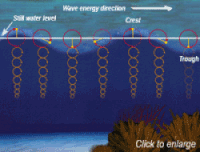Teaching Sciences by Ocean Inquiry
Laboratory Activity: Energy Transport: Waves |
|
Held at the Darling Marine Center in Walpole, ME
Summers 2006 through 2008 |
|
|
|
| |
|
ANOTHER "SPIN" ON THIS TOPIC
Waves transport energy all around us everyday. Infrared waves transport energy from the sun, radio waves transport energy to our mp3 players and microwaves transport energy to our food. The ocean is home to various types of waves such as those commonly seen breaking along the shore. These are a type of "gravity wave." (Contributed by Adam Casey, workshop TA) |
|
|
A wave is a periodic disturbance in space and/or time. By periodic we mean that its manifestation is seen at regular - or at
least predictable - intervals in time and/or space. Waves transfer energy through a medium without significantly displacing
the medium itself (see image below). To better understand this concept, think of "The Wave" at sporting events: there is an
appearance of a wavelike motion but the people do not move away from their seats.
What can waves tell us about the ocean?
A wave packet is a finite disturbance in space and is encountered in many ocean applications (e.g., earthquakes, tsunamis,
tidal bores). There are many examples of waves in fluids; from gravity waves (where the restoring force is gravity), to
capillary waves (where the restoring force is surface tension), to sound (pressure waves) and light (electromagnetic waves),
just to name a few. Tsunamis, tides, beach surf waves, and ripples are all gravity waves.
Waves have speeds associated with the movement of a crest (or trough) which are not necessarily the speed that energy is transferred by. One way to see this is by throwing a stone into a pond. You will observe crests that appear at the center and disappear at the outer edge of the disturbance; note that the disturbance itself propagates out at half the speed that the crests (or troughs) are moving.
How might this workshop benefit my students?
The hands-on activities presented in this lab were designed to explore characteristics of shallow waves, internal waves, and sound. Full details and explanations of stations are available by clicking here (2.9 MB PDF file).
|






